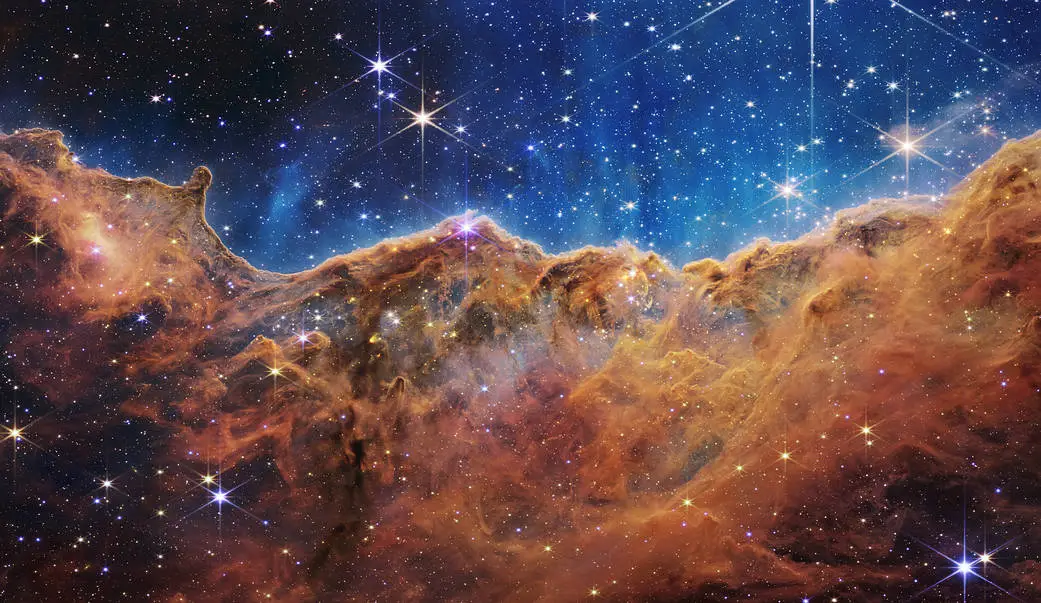
Can dust evaporate in harsh interstellar environments?
24-04-2024
Dust represents an important component of the interstellar medium of galaxies and is involved in various physical processes. As a consequence, it is crucial to understand the factors that influence its formation and destruction. In a recent study, a team of scientists led by dr hab. Ambra Nanni of the NCBJ’s Astrophysics Division analysed the effect of photo-evaporation on the survival of dust in the interstellar medium of galaxies.
The dust particles that exist in space are not only responsible for the formation of new molecules and the cooling of the gas (which has a direct effect on the formation of new stars), but also, by absorbing and emitting radiation, they affect the spectral energy distribution of galaxies and the estimate of their physical properties, such as the star formation rate and stellar mass. The amount of dust in galaxies is changing through processes such as astration (the incorporation of gas and dust into newly formed stars), shock waves from supernovae, and large-scale galactic outflows. Another phenomenon that can affect the amount of dust in galaxies is the so-called photo-evaporation, although its efficiency has not been established yet.
In areas of intense star formation and around Planetary Nebulae, a large amount of energetic radiation is produced. Photons in the ultraviolet and visible range are absorbed by dust particles that heat up and evaporate if they attain large enough temperatures. Therefore, this process (usually called „photo-evaporation”) may be contributing to the destruction of interstellar dust, especially in low-metallicity galaxies and in the early Universe, when stars were hotter and thus able to produce an intense radiation field. The impact of photo-evaporation on galaxy evolution has been the subject of a study involving a group of scientists from the NCBJ’s Astrophysics Division, led by dr hab. Ambra Nanni.
Theoretical models that describe the evolution of gas, metals and dust in galaxies include a description of the processes of formation, growth and removal of dust. In these, the decreasing amount of dust over time is mainly attributed to phenomena such as outflows and/or supernova shocks, but recent observations suggest that dust destruction is likely to occur through different routes, depending on their evolutionary stage. „This led to our interest in studying the influence of different processes on the survival of dust in the interstellar medium of galaxies,” describes dr hab. Ambra Nanni of the NCBJ’s Astrophysics Division, first author of the publication. „We focused on whether, in addition to shock waves from supernovae, galactic outflows and the process of astration, photo-evaporation could efficiently contribute to the disappearance of dust in the interstellar medium.”
The team analysed the results of the gas and dust evolution model taking into account all of the above processes, and different scenarios including a short (less than hundred million years) and long (of order of billions of years) star-formation timescale, and the effect of environment (whether stars are isolated or in clusters. The results obtained made it possible to determine the fraction of dust that was destroyed by the photo-evaporation phenomenon. „We found that this phenomenon is responsible for destroying a very small fraction of the dust in galaxies, of the order of 10–8 – 10–6 per solar mass of stars formed, depending on different factors, e.g. in the surroundings of massive star-forming clusters, more dust evaporates than if stars are formed in isolation,” explains dr hab. Nanni. „Thus, it turns out that photo-evaporation plays a marginal role in the changes of dust abundance. In addition, in astronomical observations we are usually able to determine the dust-to-stellar mass ratio with an accuracy of the order of 10–4, that is much larger than the predicted contribution of photo-evaporation to the dust destruction processes in the interstellar medium.”
The full results of the study are available in the publication: Dust survival in harsh environments. Investigating the relevance of photo-evaporation process; A. Nanni, S Cristallo, D. Donevski, M.J. Michałowski, M. Romano, P. Sawant, A&A, DOI: https://doi.org/10.1051/0004-6361/202348024




